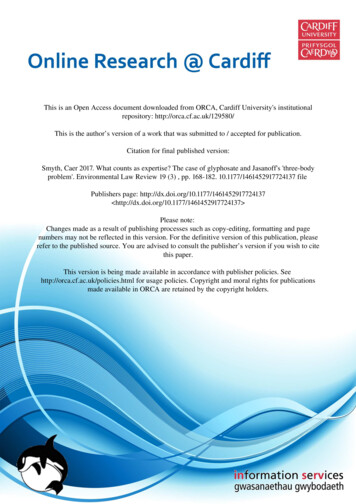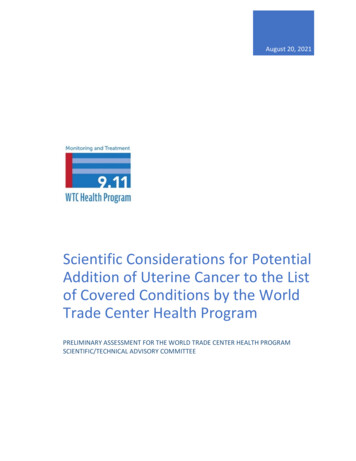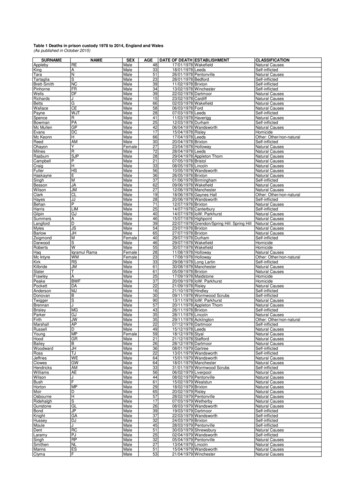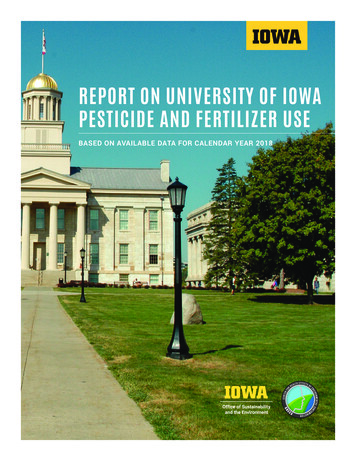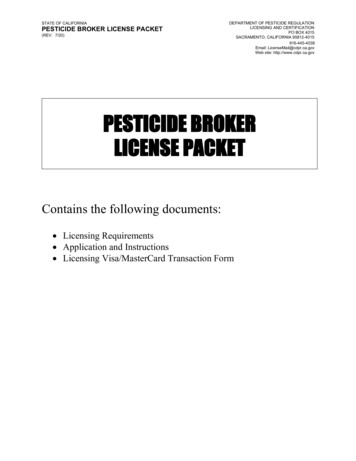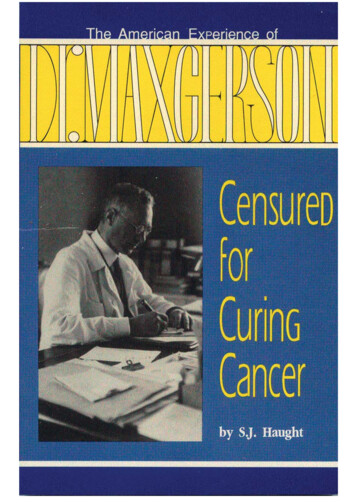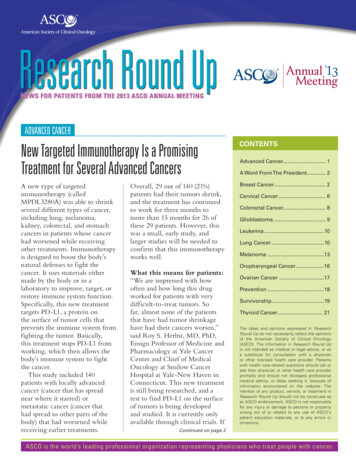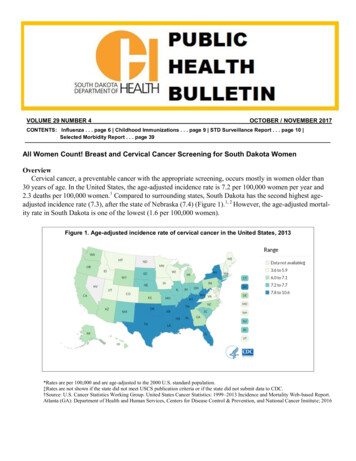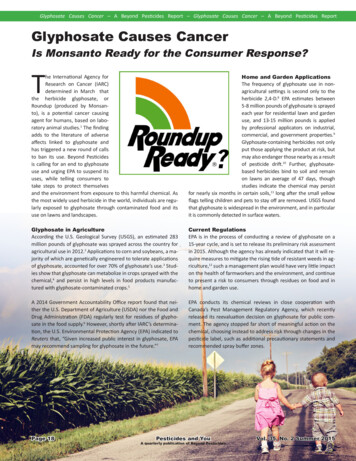
Transcription
Glyphosate Causes Cancer – A Beyond Pesticides Report – Glyphosate Causes Cancer – A Beyond Pesticides ReportGlyphosate Causes CancerIs Monsanto Ready for the Consumer Response?THome and Garden Applicationshe International Agency forResearch on Cancer (IARC)determined in March thatthe herbicide glyphosate, orRoundup (produced by Monsanto), is a potential cancer causingagent for humans, based on laboratory animal studies.1 The findingadds to the literature of adverseaffects linked to glyphosate andhas triggered a new round of callsto ban its use. Beyond Pesticidesis calling for an end to glyphosateuse and urging EPA to suspend itsuses, while telling consumers totake steps to protect themselvesand the environment from exposure to this harmful chemical. Asthe most widely used herbicide in the world, individuals are regularly exposed to glyphosate through contaminated food and itsuse on lawns and landscapes.The frequency of glyphosate use in nonagricultural settings is second only to theherbicide 2,4-D.8 EPA estimates between5-8 million pounds of glyphosate is sprayedeach year for residential lawn and gardenuse, and 13-15 million pounds is appliedby professional applicators on industrial,commercial, and government properties.9Glyphosate-containing herbicides not onlyput those applying the product at risk, butmay also endanger those nearby as a resultof pesticide drift.10 Further, glyphosatebased herbicides bind to soil and remainon lawns an average of 47 days, thoughstudies indicate the chemical may persistfor nearly six months in certain soils,11 long after the small yellowflags telling children and pets to stay off are removed. USGS foundthat glyphosate is widespread in the environment, and in particularit is commonly detected in surface waters.Glyphosate in AgricultureCurrent RegulationsAccording the U.S. Geological Survey (USGS), an estimated 283million pounds of glyphosate was sprayed across the country foragricultural use in 2012.2 Applications to corn and soybeans, a majority of which are genetically engineered to tolerate applicationsof glyphosate, accounted for over 70% of glyphosate’s use.3 Studies show that glyphosate can metabolize in crops sprayed with thechemical,4 and persist in high levels in food products manufactured with glyphosate-contaminated crops.5EPA is in the process of conducting a review of glyphosate on a15-year cycle, and is set to release its preliminary risk assessmentin 2015. Although the agency has already indicated that it will require measures to mitigate the rising tide of resistant weeds in agriculture,12 such a management plan would have very little impacton the health of farmworkers and the environment, and continueto present a risk to consumers through residues on food and inhome and garden use.A 2014 Government Accountability Office report found that neither the U.S. Department of Agriculture (USDA) nor the Food andDrug Administration (FDA) regularly test for residues of glyphosate in the food supply.6 However, shortly after IARC’s determination, the U.S. Environmental Protection Agency (EPA) indicated toReuters that, “Given increased public interest in glyphosate, EPAmay recommend sampling for glyphosate in the future.”7EPA conducts its chemical reviews in close cooperation withCanada’s Pest Management Regulatory Agency, which recentlyreleased its reevaluation decision on glyphosate for public comment. The agency stopped far short of meaningful action on thechemical, choosing instead to address risk through changes in thepesticide label, such as additional precautionary statements andrecommended spray buffer zones.Page 18Pesticides and YouA quarterly publication of Beyond PesticidesVol. 35, No. 2 Summer 2015
Glyphosate Causes Cancer – A Beyond Pesticides Report – Glyphosate Causes Cancer – A Beyond Pesticides Report“Probable” carcinogen: what does that mean for my health?It’s easy for consumers to say, and no doubt many activists have heard, the refrain that “everything causes cancer.” Often thisstatement is used as a reason to brush-off needed action on industrial contaminants –after all, we’re exposed to hundreds ofenvironmental chemicals each day, so why worry about a “probable” carcinogen, the ranking IARC has given to glyphosate?Rather than throw our collective hands up, the prospect of recurring chemical exposure should rally us to address these healthconcerns and seek out alternatives when credible and respected scientific agencies make such determinations. A look intoIARC’s evaluation process showcases the gravity of these classifications. IARC employs a “strength of evidence” assessment,basing the carcinogenicity of a chemical on whether it is capable of increasing the occurrence of malignant growths,13 reducingtheir latency (time between exposure and the onset of cancer), or increasing the severity or multiplicity of such growths. Priorto classifying a chemical, 17 experts from 11 countries analyzed scientific studies and data for approximately one year beforemeeting together in a Working Group in an attempt to reach a consensus evaluation. Consideration is given to exposure data,studies of cancer in humans, studies of cancer in experimental animals, and mechanistic and other relevant data.[Note: cancer ratings are based on studies of laboratory animals, since we do not test chemicals on humans. In some casesthere is epidemiologic evidence, often from workplace data that links chemical exposure to a cancer effect. However, sincethe point of testing is to inform regulatory decisions to prevent exposure to carcinogens, glyphosate’s cancer ranking as the highestpossible rating for carcinogenicity in humans based on laboratoryexperts from 11 countriesdata is extremely meaningful.]analyzed scientific studies anddata for approximately one yearbefore meeting together in a Working Group in anChemicals are placed into one of four categories: Group 1: Is Carcinogenic to Humansattempt to reach a consensus evaluation. ConsiderSufficient evidence of carcinogenicity in both humans andation is given to exposure data, studies of cancer inexperimental animals,humans, studies of cancer in experimental animals, Group 2:and mechanistic and other relevant data.”(A) Probably Carcinogenic to HumansLimited evidence of carcinogenicity in humans; Sufficientevidence of carcinogenicity in experimental animals(B) Possibly Carcinogenic to HumansLimited evidence of carcinogenicity in humans; Less than sufficient evidence of carcinogenicity in experimental animals Group 3: Not Classifiable as to its Carcinogenicity in HumansInadequate evidence of carcinogenicity in humans; limitedevidence of carcinogenicity in experimental animals Group 4: Probably not Carcinogenic to HumansEvidence suggests lack of carcinogenicity in humans andexperimental animals14“17Glyphosate falls in IARC’s group 2A classificationHuman data available to IARC was based on research conductedsince 2001. “Case-control studies of occupational exposure in theUSA, Canada, and Sweden reported increased risks for non-Hodgkin lymphoma that persisted after adjustment for otherpesticides,” according to IARC’s article in The Lancet Oncology. In its monograph, the agency notes that EPA previously classified glyphosate as a possible carcinogen in humans based on studies that show tumors in mice, yet in 1991, the agencychanged its classification to evidence of non-carcinogenicity in humans after a re-evaluation of the study. IARC used bothEPA’s report and more recent data in its conclusion that there was sufficient evidence of the carcinogenicity of glyphosatein experimental animals.“There were several studies. There was sufficient evidence in animals, limited evidence in humans and strong supporting evidence showing DNA mutations . and damaged chromosomes,” said Aaron Blair, Ph.D., chair of the IARC Working Group and ascientist emeritus at the National Cancer Institute, in an interview with Reuters.15Vol. 35, No. 2 Summer 2015Pesticides and YouA quarterly publication of Beyond PesticidesPage 19
Glyphosate Causes Cancer – A Beyond Pesticides Report – Glyphosate Causes Cancer – A Beyond Pesticides ReportTake Action!Consumers should not have to wait for federal regulators to act in order to address glyphosate use and contaminated foods in theircommunity. Take the following five steps, all of which can be started immediately, to reduce glyphosate use for you, your family,and our communities at-large.Tamp Down on Roundup1) Buy organic foods.Because organic standards, withfew exceptions, do not allow theuse of any toxic synthetic pesticides in food production, buyingorganic is the only surefire way toprevent glyphosate in your diet.Choosing organic also meansbuying into an agricultural system that protects farmworkers,prevents water contamination,and safeguards wildlife.2) Stop the use of lawn care products like Roundup, which containglyphosate.You don’t need to be an organicfarmer or master gardener tomanage your lawn without theuse of pesticides and herbicideslike Roundup. Alternative pracMarch Against Monsanto protest outside of White House in May 2015. Monsanto is the leading producer oftices are available to help createglyphosate. Photo Courtesy Ford Fischer/News2Share www.news2share.comconditions where weeds do notbecome a significant problem,and new least-toxic herbicides are available to help with your4) Join with other concerned residents in your community andtransition to organic, or in those increasingly rare instanceswork toward a resolution prohibiting toxic lawn care herbicideswhen weeds do get out of control. See Beyond Pesticides’from being used in your town.Lawns and Landscapes resources for assistance: www.beyonStarting a movement isn’t easy, but it is amazing how quicklydpesticides.org/lawn.you can pick up steam with the right information to the rightlocal leaders, and a group of committed individuals. See Be3) Voice your concerns about glyphosate to your local groceryyond Pesticides’ fact sheet on how to Start Your Own Localand home improvement store, and encourage them not to sellMovement s containing or sprayed with glyphosate.mentFactsheet.pdf] for the basics you’ll need to begin yourForward-looking home improvement stores are already startcampaign to stop the use of glyphosate in your community.ing to ditch lawn care pesticides like Roundup in favor ofleast-toxic alternatives. Tell your local hardware stores to stop5) Write letters and sign petitions to EPA, USDA, and otherselling glyphosate-based herbicides (and that aisle filled withelected officials.pesticides, while you’re at it!).Although signing a petition against glyphosate [http://bit.ly/StopGlyphosatePetition] like the one Beyond Pesticides has createdYour grocery store should also hear about your concerns with glyphois a simple step, after you take action we encourage you to craftsate-sprayed crops. Let them know that food laced with a probableyour own unique letter to your local, state, and federal represencarcinogen is not acceptable for you or your family’s health.tatives, as well as officials at EPA and USDA. Let them know thatyou’re not okay with a carcinogen on our lawns and in our food.While both these retailers might say they can’t control thesourcing of their products, make sure your message gets toFor help completing these actions, please don’t hesitate to conmanagers, who will report back to owners or corporate headtact Beyond Pesticides at info@beyondpesticides.org or by callquarters.ing 202-543-5450.Page 20Pesticides and YouA quarterly publication of Beyond PesticidesVol. 35, No. 2 Summer 2015
Glyphosate Causes Cancer – A Beyond Pesticides Report – Glyphosate Causes Cancer – A Beyond Pesticides ReportA World Without GlyphosateAs we consider the end of the herbicide glyphosate (Roundup), the question that comes to mind is what will replace it.Of course, there are replacement products that are available for people and communities considering the shift awayfrom toxic pesticide products. But, the long-term solution requires the adoption of organic systems that focus first onpractices and prevention and, only second and as a last resort, on alternative products. Predictably, and regardless of the International Agency for Research on Cancer’s classification for glyphosate, this question of alternatives to the weed killer has beenemerging because of widespread weed resistance to glyphosate.BackgroundThe widespread use and reliance on glyphosate, and the simultaneous reductions in the use of sustainable weed managementpractices, has resulted in glyphosate-resistant weeds. In regions of the U.S. where Roundup-Ready (glyphosate-tolerant) cropsdominate, there are now evolved glyphosate-resistant populations of economically-damaging weed species. Growers of GEcotton in 2014 asked for an emergency use of the herbicide propazine due to weed resistance across three million acres. The request was denied by EPA because public exposure to triazine herbicides (propazine’s chemical cousin with atrazine and others)in the aggregate already showed unacceptable risk levels. Pursuing sustainable alternatives can prevent the pesticide treadmillthat results from the use of GE crops and pesticides like glyphosate. Ecological pest management strategies, organic practices,and solutions that are not chemical-intensive are the most appropriate and long-term solution to managing unwanted plantsor weeds.Common Glyphosate UsesAn organic, feed-the-soil approach to the growing of plants, including turf, is the most sustainable and cost-effective. With thissystems approach in organic lawns, landscapes, and agriculture, we enhance soil health, beneficial bacteria and fungi in the soil,natural nutrient cycling, crop rotation, and incorporate organic compatible management practices and products.AgricultureThe Roundup-Ready crops (soy, corn, canola, alfalfa, cotton, sorghum) can all be grown organically and, in fact, are a part of the 40 billion organic industry that continues to grow. Shifting to newer herbicide-tolerant varieties, such as those that are nowtolerant of the herbicide 2,4-D (Enlist Duo), only postpones resistance while exposing people and the environment to anothercancer causing agent that is also an endocrine disruptor.Lawns and LandscapesThe principles of organic are available for all of glyphosate uses: fence lines, utility poles, sidewalks, driveways, garden beds,roadsides and medians, rights-of-way, and parks. For all these current uses, there are either opportunities for mechanical removal (goats, flame and steam weeding, hand pulling), mulching systems and cultural practices (landscape fabric, high mowing,hedgerows, or organic compatible products (horticultural vinegar, herbicidal soaps, essential oils, corn gluten meal).Please see Beyond Pesticides’ page www.beyondpesticides.org/lawn for more information on alternatives to glyphosate.Monsanto and the Industry ResponseIn response to the IARC cancer finding on glyphosate, Monsanto has objected strenuously. Monsanto’s official position: “The 2Aclassification does not establish a link between glyphosate and an increase in cancer. “Probable” does not mean that glyphosatecauses cancer and IARC’s conclusion conflicts with the overwhelming consensus by regulatory bodies and science organizationsaround the world, like the U.S. EPA, which concluded that there is evidence of non-carcinogenicity.” There no doubt will beindustry supported efforts to undercut the finding of this respected scientific body of the World Health Organization. An assessment by the German Federal Institute for Risk Assessments (BfR), which takes the non-carcinogen position, is based almost solely on industry science and classified industry reports provided to it by the Glyphosate Task Force, an industry consortium led byMonsanto. Three scientists on Germany’s scientific panel on pesticides work for the pesticide industry. BfR and IARC’s findingshave been released during a pivotal time, as a decision on whether to extend the license for glyphosate’s use in Europe is currently pending, and these studies are sure to be incorporated into the decision making process. Meanwhile, glyphosate is beingtaken off the shelves by companies across Europe and member states are calling for the European Union to ban the chemical.Vol. 35, No. 2 Summer 2015Pesticides and YouA quarterly publication of Beyond PesticidesPage 21
Glyphosate Causes Cancer – A Beyond Pesticides Report – Glyphosate Causes Cancer – A Beyond Pesticides International Agency for Research on Cancer. 2015. IARC Monographs Volume 112: evaluation of five organophosphate insecticides and herbicides. nographVolume112.pdfUnited States Geologic Survey. 2015. Pesticide Use Maps. Estimated Agricultural Use for Glyphosate, 2012. http://water.usgs.gov/nawqa/pnsp/usage/maps/show map.php?year 2011&map GLYPHOSATE&hilo H&disp GlyphosateIbidArregui, Maria et al. 2003. Monitoring glyphosate residues in transgenic glyphosate-resistant soybean. Pest Management Science. 60:163–166. DOI: 10.1002/ps.775Rubio, Fernando et al. 2014. Survey of Glyphosate Residues in Honey, Corn and Soy Products. Journal of Environmental andAnalytical Toxicology. 5:249. doi: 10.4172/2161-0525.1000249Government Accountability Office. 2014. FDA and USDA Should Strengthen Pesticide Residue Monitoring Programs and Further Disclose Monitoring Limitations. GAO-15-38 http://www.gao.gov/products/GAO-15-38Reuters. 2015. U.S regulators may recommend testing food for glyphosate residues. mental Protection Agency. 2013. 2006-2007 Pesticide Market Estimates. Usage (Page 3). usage2007 3.htm#3 7Ibid.Environmental Protection Agency. 2014. Introduction to Pesticide Drift. duction-pesticide-driftBeyond Pesticides. 2014. ChemicalWatch Factsheet. Glyphosate. ets/Glyphosate.pdfGillam, Carey. 2015. EPA regulator says set to release key herbicide report, lauds biopesticides. Reuters. ational Agency for the Research on Cancer. 2006. Preamble to the IARC Monographs (Amended January 2006). id.Gillam, Carey. 2015. Scientist defends WHO group report linking herbicide to cancer. Reuters. -herbicide-idUSL2N0WS1SC20150326Vol. 35, No. 2 Summer 2015Pesticides and YouA quarterly publication of Beyond PesticidesSupplemental Page
studies of cancer in humans, studies of cancer in experimental animals, and mechanistic and other relevant data. [Note: cancer ratings are based on studies of laboratory animals, since we do not test chemicals on humans. In some cases there is epidemiologic evidence, often from workplace data that lin


